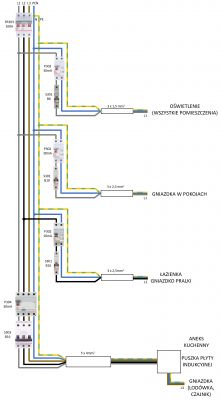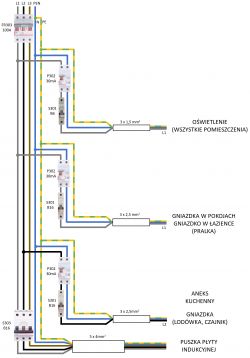Hello,
On the occasion of a major renovation in the apartment, I decided to give up using gas in favor of an induction hob. It is a small flat (40m2) in a block from the 60s with an old single-phase, two-wire aluminum wiring, so I would like to replace everything with copper with a protective conductor. The connection power has already been increased to 11kW 3ph (TN-C system, overcurrent protection in the C20 staircase).
Planned protections:

I'd like your opinion on two things:
1) Should a four-circuit differential be used as protection for an induction hob?
From what I've noticed, the induction hobs I've seen so far are actually two-phase powered, i.e. 2x240V with the possibility of connecting to two independent circuits (i.e. L1-N1 and L2-N2). I have not yet come across a board that would be powered from 400V phase-to-phase, e.g. in a delta configuration. Therefore, if I use the connection as shown in the diagram with the common N wire, there is a risk that in the event of a discontinuity in the N path, there will be a voltage above 240V, which may damage the electronics controlling the board. But in that case, should each phase be pulled to the plate separately with a separate neutral wire? What solution is the most secure for the board (and its users), and at the same time the most universal and "future-proof"? (as of today, I still don't know which album I will finally buy)
2) Is it a good idea to use a 10mA differential for the bathroom socket?
As you know, the bathroom is the most sensitive room when it comes to the risk of electric shock, so I would like it to be as safe as possible. On the other hand, I do not know what the leakage in the washing machine can be and whether it will not end up with too frequent disconnection of the RCD when in fact nothing dangerous is really happening. In this case, would it be better to connect the bathroom together with the sockets in the rooms to a common circuit protected with a standard RCD 30mA and B16, supplying it from the L2 phase?
Of course, I will be grateful if you point out any other errors you spot.
Thank you and best regards.
On the occasion of a major renovation in the apartment, I decided to give up using gas in favor of an induction hob. It is a small flat (40m2) in a block from the 60s with an old single-phase, two-wire aluminum wiring, so I would like to replace everything with copper with a protective conductor. The connection power has already been increased to 11kW 3ph (TN-C system, overcurrent protection in the C20 staircase).
Planned protections:

I'd like your opinion on two things:
1) Should a four-circuit differential be used as protection for an induction hob?
From what I've noticed, the induction hobs I've seen so far are actually two-phase powered, i.e. 2x240V with the possibility of connecting to two independent circuits (i.e. L1-N1 and L2-N2). I have not yet come across a board that would be powered from 400V phase-to-phase, e.g. in a delta configuration. Therefore, if I use the connection as shown in the diagram with the common N wire, there is a risk that in the event of a discontinuity in the N path, there will be a voltage above 240V, which may damage the electronics controlling the board. But in that case, should each phase be pulled to the plate separately with a separate neutral wire? What solution is the most secure for the board (and its users), and at the same time the most universal and "future-proof"? (as of today, I still don't know which album I will finally buy)
2) Is it a good idea to use a 10mA differential for the bathroom socket?
As you know, the bathroom is the most sensitive room when it comes to the risk of electric shock, so I would like it to be as safe as possible. On the other hand, I do not know what the leakage in the washing machine can be and whether it will not end up with too frequent disconnection of the RCD when in fact nothing dangerous is really happening. In this case, would it be better to connect the bathroom together with the sockets in the rooms to a common circuit protected with a standard RCD 30mA and B16, supplying it from the L2 phase?
Of course, I will be grateful if you point out any other errors you spot.
Thank you and best regards.



